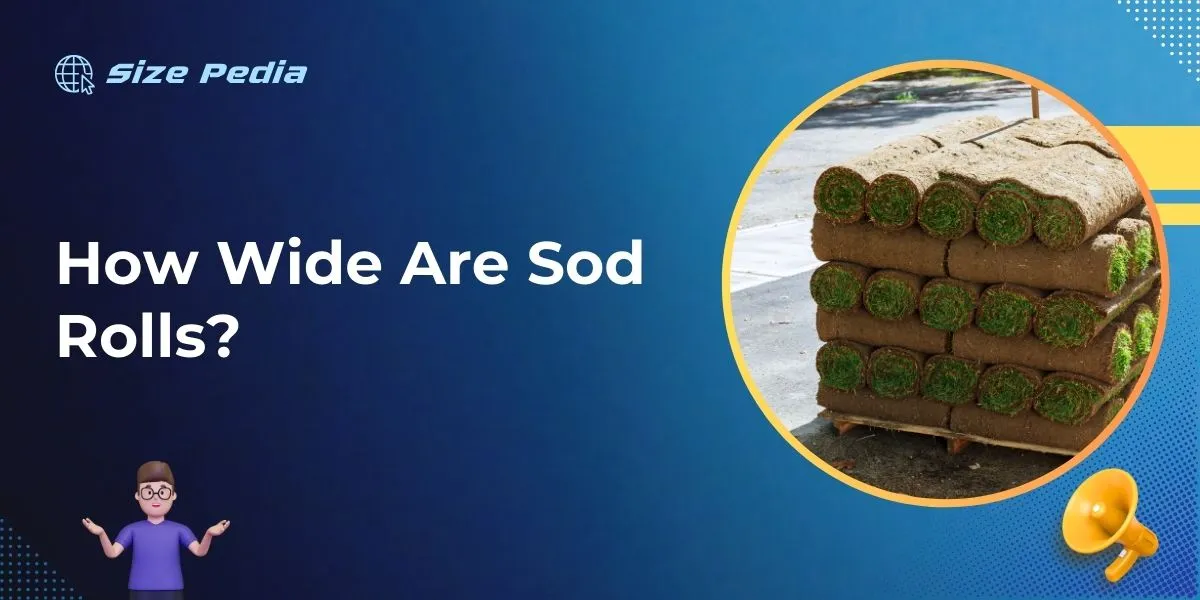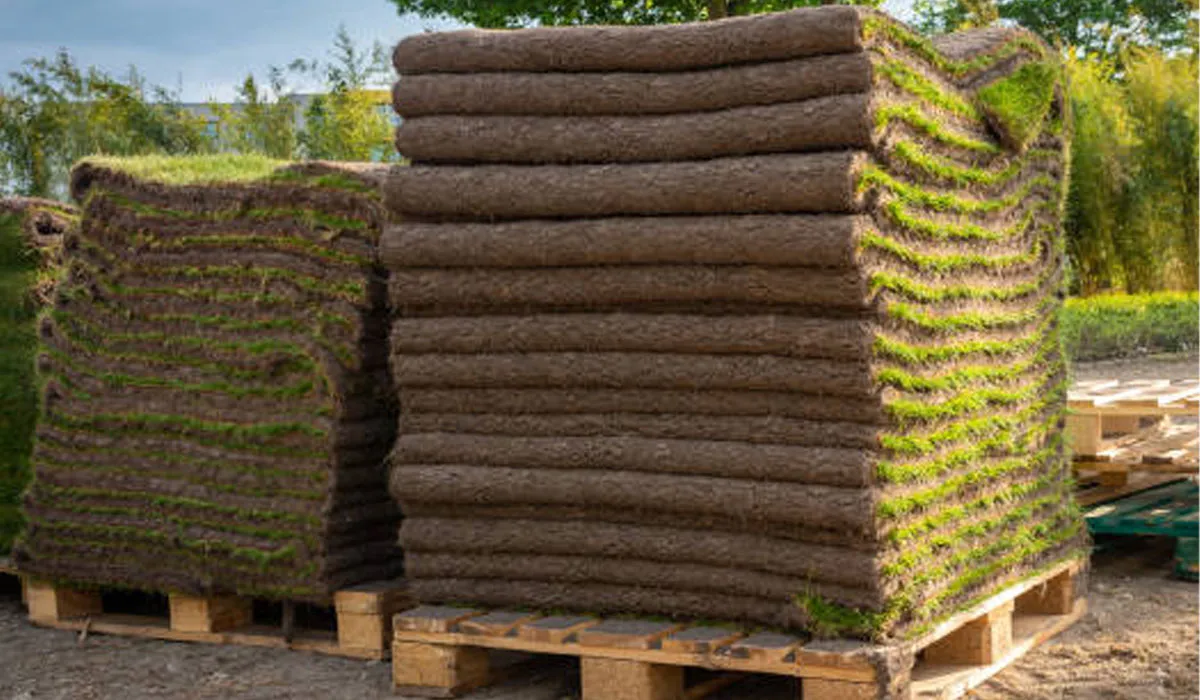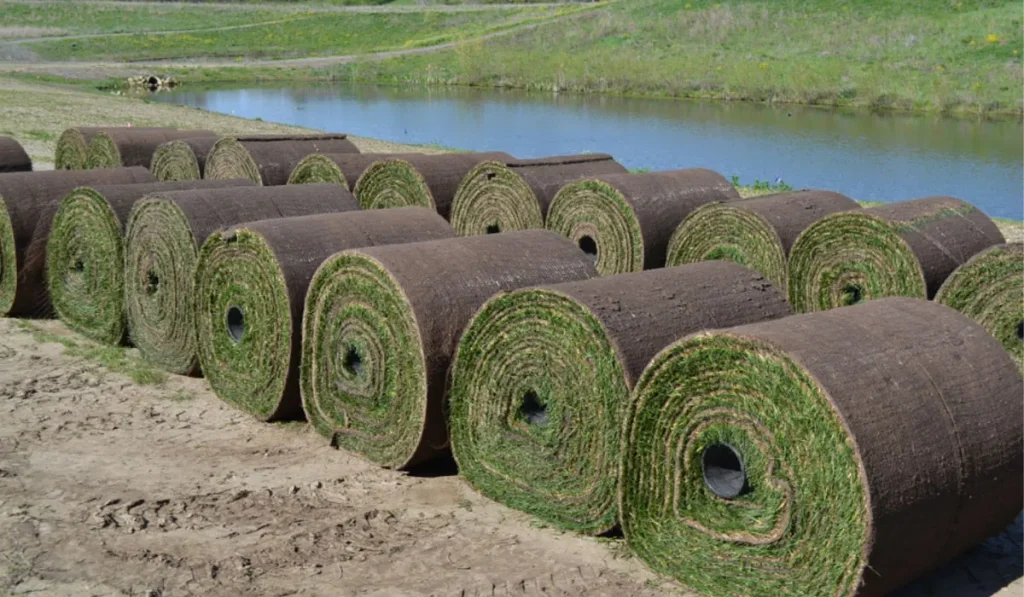Sod rolls typically measure 24 inches wide. Their length can vary, usually spanning from 54 to 108 inches.
Gardening and landscaping enthusiasts often seek quick and effective solutions for lawn establishment, leading many to choose sod for its immediacy in creating lush, green spaces.
Sod rolls are a popular choice due to their manageable size, which facilitates easy transport and installation.
These pre-grown grass patches save time compared to seeding and provide an instant aesthetic upgrade. With each roll covering a specific area, buyers must understand sod dimensions for accurate coverage calculations.
Engaging in the preparation of landscapes with sod involves not just knowing the size but also the type of grass suitable for the climate and the soil condition of the area, ensuring a successful installation and a thriving lawn.

Basics Of Sod Roll Sizes
When planning to lay a green carpet of grass, understanding sod roll sizes is crucial. Just like buying wallpaper or fabric, sod comes in rolls that can dramatically affect the installation process.
Knowing the standard sizes helps in estimating how much sod is needed and in preparing for an efficient install.
Common Sod Roll Measurements
Common sod roll sizes are quite consistent across many suppliers. These measurements influence how quickly an area can be covered and the ease of handling the rolls.
Sometimes, rolls also come in slabs or squares, especially for smaller areas. Below, find the widespread measurements for sod rolls:
- Width: Generally, sod rolls are 18 to 24 inches wide.
- Length: Rolls often measure between 54 to 72 inches long.
- Area: One roll usually covers about 9 to 12 square feet.
- Weight: A single sod roll may weigh 15 to 30 pounds, depending on moisture content.
Variations By Region And Provider
Different areas and suppliers may offer unique sod roll sizes. These variations consider the climate, transportation, and specific customer needs.
Let’s look at a few factors that lead to these differences:
| Region | Common Roll Size | Adjustments for Climate |
|---|---|---|
| Northern Regions | 24″ x 72″ | Larger for efficient coverage in cooler climates |
| Southern Regions | 18″ x 54″ | Smaller for easier handling in warmer climates |
Certain providers might customize roll sizes for special projects such as sports fields or unique landscape designs. It is important to check with local sod farms or providers to get the exact sizes available in your area.
Remember to always measure the area where sod will be applied to calculate how many rolls are necessary for your project. Efficient planning saves time, money, and resources. Happy sodding!
Factors Impacting Sod Roll Width

Understanding the factors that determine sod roll width is crucial for landscaping projects. From residential lawns to expansive sports fields, sod roll dimensions play a pivotal role in planning and installation efficiency.
Different aspects, such as turf species and the methods used during harvesting, influence the width of sod rolls before they reach your garden.
Turf Species And Growth Patterns
Selecting the right sod for your project begins with understanding the unique characteristics of various turf species. Each species has distinctive growth patterns that can affect the size and health of sod rolls:
- Tall Fescue: Known for its deep roots and broad leaves. It requires larger rolls.
- Bermuda Grass: With its fine texture, it adapts well to tight rolls.
- St. Augustine: Its coarse texture often means wider roll dimensions.
Recognizing these patterns is essential when determining the optimum roll width for seamless lawn coverage.
Manufacturing And Harvesting Processes
The equipment and techniques used in producing sod can significantly influence roll size. Some key aspects include:
| Process | Impact on Width |
|---|---|
| Cutting Blades | Different blade sizes cut rolls at varying widths. |
| Rolling Method | Automated rollers can create uniform and custom widths. |
Quality control throughout the manufacturing process ensures the resulting rolls meet industry standards for both width and health, providing the perfect foundation for beautiful, lush lawns.
Practical Uses Of Different Sod Sizes
Understanding sod size helps pick the right option for projects. Sod rolls come in various widths and lengths. This choice impacts installation time and labor costs.
Residential Vs. Commercial Projects
Home lawns and commercial spaces use sod. Their needs differ. Sod sizes must match the project’s scale for efficiency.
- Residential projects: Standard rolls. Easy to handle. Fit small yards.
- Commercial projects: Large rolls. Cover more ground. Save time on big areas.
| Sod Type | Width | Length | Area |
|---|---|---|---|
| Standard Roll | 18″ | 6′ | 9 ft2 |
| Large Roll | 24″ | 50′ | 100 ft2 |
Landscaping And Athletic Fields
Landscaping benefits from precise sod sizes. Athletic fields require larger pieces.
- Landscaping: Use various sizes. Creates intricate designs. Optimizes small spaces.
- Athletic fields: Need uniform coverage. Big rolls are ideal for quick laying and root establishment.
Calculating Your Needs: Sod Roll Dimensions
Planning to lay new sod in your garden? Knowing the size of sod rolls is crucial. Precise measurements save time and money. Let’s look at how to measure your lawn area and match it with the dimensions of sod rolls.
Estimating Ground Coverage
Ahead of purchasing sod, calculate the area to cover. Measure length and width of your space. Multiply these for the area in square feet. Consider shape variations and obstacles.
- Length x Width = Area in square feet
- Include paths, garden beds, and patios in your calculations
- Buy extra sod to ensure complete coverage
Standard sod rolls often measure 24 inches wide by 54 inches long. A roll covers 9 square feet. Use this to calculate how many rolls needed.
| Sod Roll Size (Inches) | Coverage (Square Feet) |
|---|---|
| 24 x 54 | 9 |
Matching Sod Rolls To Project Scope
Your project size determines the roll count. Divide your lawn area by 9 (the standard roll coverage). Round up to get the sod roll count.
For example:
- Measure your lawn area (300 sq ft)
- Divide by a sod roll coverage (300 / 9 = 33.33)
- Round up for your final count (34 rolls)
This ensures you have enough sod to cover the entire area of your lawn without any shortage.
Installation Tips For Optimal Turf Health

Installation Tips For Optimal Turf Health
Ready to roll out a lush green carpet for your backyard? Understanding sod roll width is crucial for a successful installation. Seize these tips to secure the health and beauty of your turf.
Preparing The Soil
A solid foundation is essential for sod to take root. Kick off the process with these pointers:
- Clear debris from the area, including stones and weeds.
- Dig the top 6 to 8 inches of soil to loosen it up.
- Smooth the area with a rake to avoid any bumps or gaps.
- Enrich the soil with compost or a starter fertilizer.
Well-prepared soil invites strong growth.
Laying Sod For Best Results
It’s showtime! Follow these steps:
- Measure your garden to understand how much sod you need.
- Begin at a straight edge like a driveway or flower bed.
- Unroll the first sod strip and press down the edges firmly.
- Offset the seams in a brickwork pattern for stability.
- Keep it tight! Push the rolls together to avoid gaps.
- Water generously after laying. Aim for a deep soak.
Enjoy your new emerald stage! Proper installation leads to less watering, mowing, and hassle.
Maintaining Your Turf After Installation
After laying down those wide rolls of fresh sod to create a lush green lawn, proper maintenance is crucial. It ensures the roots take hold and the grass stays vibrant.
Here are some key tips for watering schedules, mowing, and fertilizing your new turf.
Watering Schedules
Watering your new sod is vital for its survival and growth. Start by watering twice a day for the first week. Aim for early morning and late afternoon.
This avoids the hottest part of the day. Cut back to once a day in the second week. By weeks three and four, watering every other day is enough.
After a month, weekly watering is sufficient. Ensure each session is deep enough to soak the soil underneath the sod.
Mowing And Fertilizing Recommendations
Mowing for the first time should be after your grass is rooted. This often takes about two weeks. Remember to never cut more than a third of the grass height at a time. Use a sharp blade to avoid tearing the grass.
Fertilizing gives your sod the nutrients it needs. The first fertilization should be about six weeks after installation.
Use a balanced, slow-release fertilizer. Consult your local garden center for the best type for your grass. Apply the recommended amount. Never over-fertilize as it can harm your lawn.
| After Installation | Product | Frequency |
|---|---|---|
| 6 weeks | Slow-release fertilizer | Once |
| 3 months | Grass-specific fertilizer | Every 6-8 weeks |
FAQs About the Width of Sod Rolls
How Wide Are Sod Strips?
Sod strips typically measure about 16 to 24 inches wide. Their length can vary but often stretches to 4 to 6 feet, making them easy to handle and install for lawn projects.
What Size Are Grass Rolls?
Grass rolls, commonly known as sod, typically measure 2 feet wide by 5 feet long, covering 10 square feet. Variations in size may occur depending on the supplier.
How Much Does A Big Roll Of Sod Cover?
A big roll of sod typically covers around 10 square feet. This coverage can vary, so always check the specific roll size with your supplier.
How Do You Measure For Sod Rolls?
To measure for sod rolls, calculate your lawn area in square footage by multiplying length by width. Order extra 5-10% for cutting and fitting.
Conclusion
Deciding on the right sod roll size is crucial for a seamless lawn. Standard widths typically range from 24 to 36 inches, with varying lengths.
Remember, your choice impacts installation ease and overall yard aesthetics. For a stunning, lush lawn, measure carefully and select wisely.
Happy gardening!
Resources:
https://www.federalregister.gov/documents/2023/10/16/2023-22502/natural-grass-sod-promotion-research-and-information-order
https://houstonturfgrass.com/sod-roll-sizes-sod-piece-sizes/
